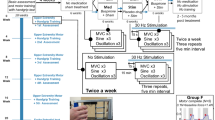Abstract
The purpose of this study was to determine the acute effects of conventional mode transcutaneous electric nerve stimulation (TENS) on the rate of selfinjurious behaviors (SIB) in two young multiply handicapped persons with mental retardation. The first individual exhibited high rates of severe selfbiting. In an alternating treatments design the TENS unit was randomly switched on or off in two daily sessions. In initial open trials SIB appeared to be clearly suppressed by TENS. During blind trials, in which the observers were kept uninformed as to the TENS status, frequency of biting was still slightly lower during active TENS conditions as compared to TENS-off conditions. The rate of a second maladaptive behavior (finger gouging) was not affected by TENS. The second individual exhibited high frequency of head banging. Two sessions, consisting of two conditions each, were scheduled daily throughout the study. During baseline periods the TENS unit was switched off. During the alternating treatments phases the unit was alternatively switched on or off in a random and predetermined fashion. The data indicate that head hitting rates were reduced by TENS, and that four concurrently recorded behaviors were unaffected by the TENS. It was concluded that TENS had selective effects on SIB in both individuals without achieving clinically significant results. TENS effects were found to continue for some time after the unit was switched off. The data are discussed as to their scientific and clinical implications.
Similar content being viewed by others
References
American Psychiatric Association (1980).Diagnostic and Statistical Manual of Mental Disorders, 3rd edition, Washington, D.C., Authors.
Ayres, A. J. (1972).Sensory Integration and Learning Disorders, Western Psychological Services, Los Angeles.
Bailey, J., and Meyerson, L. (1969). Vibration as a reinforcer with a profoundly retarded child.J. Appl. Behav. Anal. 2: 135–137.
Bailey, J., and Meyerson, L. (1970). Effect of vibratory stimulation on a retardate's self-injurious behavior.Psychol. Aspect. Disabil. 17: 133–137.
Barlow, D. H., and Hayes, S. C. (1979), Alternating treatments design: One strategy for comparing the effects of two treatments in a single subject.J. Appl. Behav. Anal. 12: 199–210.
Baumeister, A. A., Frye, G. D., and Schroeder, S. R. (1984). Neurochemical correlates of self-injurious behavior. In Mulick, J. A., and Mallory, B. L. (eds.),Transitions in Mental Retardation: Vol. 1. Advocacy, Technology, and Science, Albex, Norwood, N.J., pp. 207–227.
Cataldo, M. F., and Harris, J. (1982). The biological basis for self-injury in the mentally retarded.Anal. Intervent. Dev. Disabil. 2: 21–39.
Davidson, P. W., Kleene, B. M., Carroll, M., & Rockowitz, R. J. (1983). Effects of naloxone on self-injurious behavior.Appl. Res. Mental. Retard. 4: 1–4.
DeLissovoy, V. (1963). Head banging in early childhood: A suggested cause.J. Genetic Psychol. 102: 109–114.
Effgen, S. K., (1985). Treatment of self-injurious behavior using transcutaneous electric nerve stimulation.TOTLINE 2: 19.
Farber, J. M. (1987). Psychopharmacology of self-injurious behavior in the mentally retarded.J. Am. Acad. Child Adolescent Psychiatry 26: 296–302.
Gersh, M. R., and Wolf, S. L. (1985). Applications of transcutaneous electric nerve stimulation in the management of patients with pain.Physical Ther. 65: 314–340.
Kazdin, A. E. (1982).Single Case Research Designs, Oxford University Press, New York.
Lundberg, T. (1984). The pain suppressive effect of vibratory stimulation and transcutaneous electrical nerve stimulation (TENS) as compared to aspirin.Brain Res. 294: 201–209.
Hollis, J. H., and Meyers, C. E. (eds.) (1982).Life Threatening Behavior. Analysis and Intervention, American Association on Mental Deficiency, Washington, D.C.
Mannheimer, J. S., and Lampe, G. S. (1984).Clinical Transcutaneous Electric Nerve Stimulation, Davis, Philadelphia, Pa.
McGonigle, J. J., Rojahn, J., Dixon, J., and Strain, P. S. (1987). Multiple treatment interference in the alternating treatments design as a function of the intercomponent interval length.J. Appl. Behav. Anal. 20: 171–178.
Melzack, R., and Wall, P. D. (1965). Pain mechanisms: A new theory.Science 150: 971–979.
Murphy, G., and Wilson, B. (eds.) (1985).Self-injurious Behavior, British Institute of Mental Handicap, Kidderminster.
Rojahn, J. (1986). Self-injurious and Stereotypic behavior and noninstitutionalized mentally retarded people: Prevalence and classification.Am. J. Ment. Def. 91: 268–276.
Sandman, C. A., Datta, P. C., Barron, J., Hoehler, F. K., Williams, C., and Swanson, J. M. (1983). Naloxone attenuates self-abusive behavior in developmentally disabled clients.Appl. Res. Mental. Retard. 4: 5–11.
Schroeder, S. R., Schroeder, C. S., Rojahn, J., and Mulick, J. A. (1981). Self-injurious behavior. An analysis of behavior management techniques. In Matson, J. L., and McCartney, J. R. (eds.),Handbook Behavior Modification with the Mentally Retarded, New York, Plenum, pp. 61–115.
Shealy, C. N. (1974). Transcutaneous electrical nerve stimulation for control of pain.Clin. Neurosurg. 21: 269–277.
Singh, N. N. (1981). Current trends in the treatment of self-injurious behavior. In Barnes, L. A. (ed.),Advances in Pediatrics: Vol. 28, Year Book Medical Publishers, Chicago, pp. 377–340.
Singh, N. N., and Millichamp, C. J. (1985). Pharmacological treatment of self-injurious behavior in mentally retarded persons.J. Autism Dev. Disabil. 15: 257–267.
Tate, B., and Baroff, G. (1966). Aversive control of self-injurious behavior in a psychotic boy.Behav. Res. Ther. 4: 281–287.
Tyler, E., Caldwell, C., and Ghia, J. N. (1982). Transcutaneous electrical nerve stimulation: An alternative to the management of postoperative pain.Anesth. Analg. 61: 449–456.
Wells, M. E., and Smith, D. W. (1983). Reduction of self-injurious behavior of mentally retarded persons using sensory-integrative techniques.Am. J. Ment. Def. 87: 664–666.
Author information
Authors and Affiliations
Rights and permissions
About this article
Cite this article
Linn, D.M., Rojahn, J., Helsel, W.J. et al. Acute effects of transcutaneous electric nerve stimulation on self-injurious behavior. Journal of the Multihandicapped Person 1, 105–119 (1988). https://doi.org/10.1007/BF01098251
Issue Date:
DOI: https://doi.org/10.1007/BF01098251




